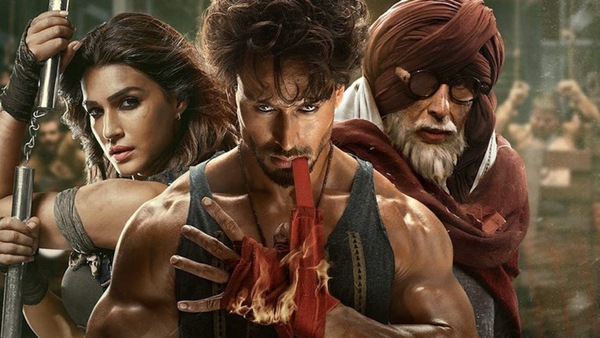Ganapath Review: Chat GPT Could Write A Better Film Than This Tiger Shroff, Kriti Sanon Starrer
On paper, Ganapath Part 1 is a scary mish-mash of tropes “borrowed” from films like Hunger Games, Mad Max, Dune and KGF. In execution, Ganapath is a dated Hindi film with an identity crisis.

Last Updated: 07.48 PM, Oct 20, 2023
I asked Chat GPT to write a synopsis of a commercial action film with futuristic and dystopian themes, starring Tiger Shroff, Kriti Sanon and Amitabh Bachchan. What I got was a generic plot of two martial artists who are caught in a war of survival in a post-apocalyptic world. And yet, even that read better than the entire “script” of Ganapath.
On paper, the film is a scary mish-mash of dumbed down tropes “borrowed” from films like Hunger Games, Mad Max: Fury Road, Dune and KGF (for desi flavour). In execution, Ganapath is like a dated David Dhawan film with an identity crisis.
Ganaapath Part 1 begins with an introduction to a fictional dystopian future (no specific year/decade mentioned) where we find out that the world is divided into two: a rich, elite class that live inside a futuristic walled city with all the resources to their name, and a raggedy poor class that survives on scraps. These less-fortunate are living with the miraculous belief that one day, a certain Ganapath will come and save them from their horrors (*somewhere, Denis Villeneuve is coughing away*).
Thalapathy (Amitabh Bachchan) leads the poor settlement and starts a wrestling culture within the community in the hopes that a brave warrior will be born from within and help them overtake the rich. Enter Guddu (Tiger Shroff). He’s the right hand man for the main villain, a ruthless John The Englishman — the controller of all illegal activities within the walled city. Guddu manages his operations. The narrative kicks off when Guddu is thrown out of the walled city and left to die for the crime of flirting with John’s girlfriend.
Now, he meets Jassi (Kriti Sanon), a fighter and revolutionary who is actively trying to enter the walled city to look for her lost mother. She brings him to Thalapathy and trains him to fight back and survive in the harsh, unforgiving landscape (very obviously shot in Ladakh). How they then band together to bring down the rich folk of the walled city and take revenge for years of oppression, makes for the rest of the film.
The above few paragraphs are the best possible representation of the story of Ganapath. However what I actually witnessed in the theatre for over two hours resembled a garbled nightmare. On paper, the story has merit — especially for a commercial Bollywood film to attempt to make an actioner with dystopian themes is very brave. Credit where credit is due for intent and guts. Unfortunately, everything else in the film falls flat on its face — starting with the cringe performances from Tiger, Kriti and pretty much everyone else (except Bachchan, who waltzes through his role).
The action set pieces, which aren’t even the least bit original (we’ve seen them all in the countless Hollywood dystopian films that have come out in the last decade), will remind you of every Tiger Shroff movie ever. The writing and dialogues don’t match the tone and setting of the film at all. There’s no creative logic to when Ganapath wants to be funny and when it wants to be a serious film. Perhaps the only saving grace of the film is that it is a relatively short one — at 2 hours and 15 mins. However, the brutal (but necessary) edits are evident through the film, with narrative gaps, random jumps in storyline and a confused overall flow.
In a world where films like Pathaan, Jawan and Gadar 2 are reviving the theatrical Hindi film business, there’s no place for a film like Ganapath. It actually sets the industry back a few years, because the Hindi cinema landscape has evolved from these formulaic tropes that we used to see almost a decade ago. Ganapath is not even an OTT-film; audiences watching from the comfort of their living rooms won’t be able to make it through the entire movie without pausing to laugh/sigh/break something. It’s a nothing-film; in that, it should just not exist.
A lot of effort has been made to package Ganapath like a futuristic story, and it’s evident that the makers are hoping that the action will overpower its other flaws, but most audience members will be able to see through this superficiality.
Tiger Shroff Tiger Shroffs his way through the film. You could take this exact performance and paste it into another film and nobody would bat an eyelid. I feel bad for Kriti Sanon, who just bagged a National Award a few days ago. I think it’s time for Sanon to strategically choose better films that don’t pull her weight down. As for Vikas Bahl — well, how and why is he still getting to direct films? I’m praying to all the cinema gods: please, please let there not be a Part 2.
(Disclaimer: The views expressed in this column are those of the author and do not necessarily reflect the official policy or position of OTTplay. The author is solely responsible for any claims arising out of the content of this column.)
Subscribe to our newsletter for top content, delivered fast.

